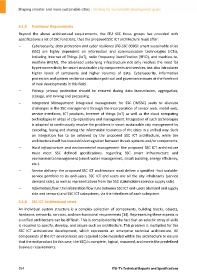Page 364 - Shaping smarter and more sustainable cities - Striving for sustainable development goals
P. 364
6.1.5 Functional Requirements
Beyond the above architectural requirements, the ITU SSC focus groups has provided with
specifications a lot of SSC functions, that the proposed SSC ICT architecture must offer:
– Cybersecurity, data protection and cyber resilience (FG‐SSC 0090): smart sustainable cities
(SSC) are highly dependent on information and communication technologies (ICTs),
including Internet of Things (IoT), radio frequency identification (RFID), and machine‐to‐
machine (M2M). The advanced underlying infrastructure not only resolves the need for
hyper‐connectivity for smart sustainable city components and services, but also introduces
higher levels of complexity and higher volumes of data. Cybersecurity, information
protection and system resilience constitute political and governance issues at the forefront
of new developments in this field.
– Privacy: privacy protection should be ensured during data transmission, aggregation,
storage, and mining and processing.
– Integrated Management: integrated management for SSC (IMSSC) seeks to alleviate
challenges in the SSC management through the incorporation of sensor web, model web,
service interfaces, ICT products, Internet of things (IoT) as well as the cloud computing
technologies in areas of city operations and management. Integration of such technologies
is adapted to continuously resolve the problems in smart sustainable city management by
encoding, fusing and sharing the information resources of the cities in a unified way. Such
an integration has to be achieved by the proposed SSC ICT architecture, while the
architecture itself has to establish integration between its sub‐systems and/or components.
– Hard infrastructure and environmental management: the proposed SSC ICT architecture
must meet SSC defined specifications, regarding SSC smart infrastructure and
environmental management (smart water management, smart building, energy efficiency,
etc.).
– Service delivery: the proposed SSC ICT architecture must deliver a specified –but scalable‐
service portfolio to its end‐users. SSC ICT end users are all the city inhabitants (service
demand side), as well as representatives from the SSC stakeholders (service supply side).
– Information flow: the information flow runs between SSC ICT end‐users (demand and supply
side and sensors) and SSC ICT subsystems, via the interfaces of each subsystem.
6.1.6 SSC ICT Architectural views
An individual system structure is a complex collection of components, building blocks, objects,
hardware, networks, services, and non‐functional requirements [14]. Representing these aspects in
a unified architecture can be difficult. This is complicated by the fact that an eclectic array of skills
is required to specify, develop, and assure such an architecture. This problem is multiplied for the
SSC ICT architecture development, which represents an enterprise technical architecture. All
components of the ICT environment are required to be modelled within the architecture to ensure
that the end product (in this case, the SSC) is complete, logical, reasoned, and meets the predefined
business requirements.
354 ITU‐T's Technical Reports and Specifications

